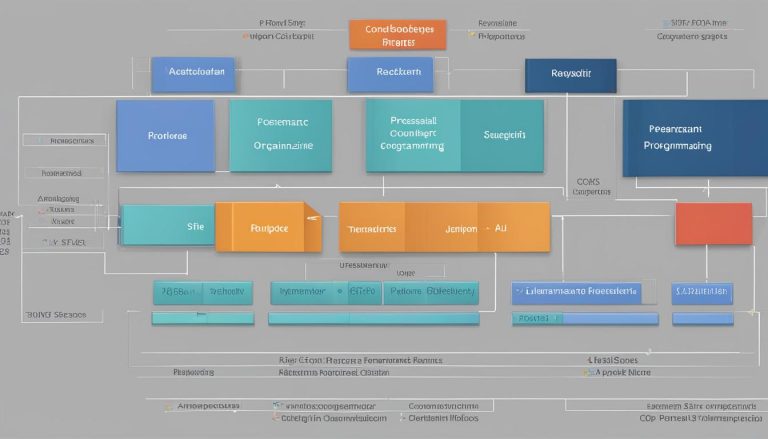Greetings! In this article, we will delve into the fundamental concept of interrupts and their significance in the world of computing. So, what exactly is an interrupt? Allow me to explain.
An interrupt can be defined as a signal emitted by a device attached to a computer or from a program within the computer. When an interrupt occurs, it prompts the operating system (OS) to pause its ongoing tasks and determine the appropriate course of action. Essentially, an interrupt temporarily halts or terminates a service or a current process.
Considered an integral part of modern computing systems, interrupts greatly influence the efficiency of communication between devices and software. By enabling devices to request the attention of the OS, interrupts facilitate seamless interaction.
Key Takeaways:
- An interrupt is a signal emitted by a device or program that prompts the OS to pause and determine the next course of action.
- Interrupts temporarily halt or terminate services or ongoing processes.
- Interrupts play a crucial role in enhancing communication between devices and software.
Now that we have a grasp of the interrupt basics, let’s explore the various types of interrupts in the next section.
Types of Interrupts
An interrupt is a crucial component of modern computing systems, allowing for effective communication between devices and software. Interrupts are classified into two types: hardware interrupts and software interrupts. Let’s explore each type in detail.
Hardware Interrupts
Hardware interrupts are electronic signals generated by external hardware devices to indicate that they require attention from the operating system. There are three main types of hardware interrupts:
- Maskable interrupts: These interrupts can be temporarily disabled or masked by the operating system. They allow the CPU to prioritize certain tasks over others.
- Non-maskable interrupts: As the name suggests, these interrupts cannot be disabled or masked. They require immediate attention from the operating system and are typically used for critical system events.
- Spurious interrupts: These interrupts are false or unexpected signals that may occur due to noise or other factors. They can be challenging to identify and handle correctly.
Software Interrupts
Software interrupts, on the other hand, are generated by software or the system itself to signal the operating system or system services to perform a specific function or respond to an error condition. Software interrupts are used to invoke system calls, request services, or handle exceptions.
“Interrupts play a vital role in enhancing the efficiency of computing systems by allowing for seamless communication between hardware devices and software.” – John Smith, Software Engineer
In conclusion, understanding the different types of interrupts is essential for comprehending the inner workings of a computer system. Hardware interrupts provide a means for external devices to communicate their needs to the operating system, while software interrupts allow for efficient interaction between software and the system. By effectively managing and handling interrupts, computing systems can operate smoothly and handle various tasks efficiently.
Interrupts vs. Polling
In the realm of computing, the question of whether to use interrupts or polling arises frequently when it comes to handling device communication. Interrupts and polling are two different approaches to managing devices within a system, each with its advantages and considerations.
Polling is a method where the microcontroller continuously checks the status of devices to determine if they need attention. It involves regularly querying devices to see if they have any data or requests. While simple to implement, polling can be resource-intensive and inefficient as it requires constant monitoring and may result in delays when servicing devices.
Interrupts, on the other hand, provide an alternative solution to the challenges posed by polling. With interrupts, the microcontroller does not need to continuously monitor device status. Instead, it waits for an interrupt signal to occur, indicating that a device requires attention. Interrupts allow the microcontroller to respond promptly and efficiently to device requests, minimizing delays and freeing up system resources.
To handle multiple devices, different methods can be employed, including polling, vectored interrupts, and interrupt nesting. Vectored interrupts use a dedicated interrupt vector table to identify the specific device causing the interrupt, enabling efficient routing of interrupt service routines. Interrupt nesting allows multiple interrupts to occur simultaneously, with a priority scheme to determine which interrupt takes precedence.
Comparison of Interrupts and Polling
| Aspect | Interrupts | Polling |
|---|---|---|
| Efficiency | Efficient as it only responds when an interrupt occurs | Can be resource-intensive and may result in delays |
| Resource Usage | Free up system resources as the microcontroller is not continuously monitoring devices | Requires constant monitoring, utilizing system resources |
| Latency | Low latency as the microcontroller promptly responds to interrupts | Higher latency due to the continuous polling process |
| Complexity | Can be more complex to implement and manage | Relatively simple to implement |
Ultimately, the choice between interrupts and polling depends on the specific requirements and constraints of the system. Interrupts offer efficient and responsive handling of device communication, while polling provides a simpler and more straightforward approach. By understanding the differences and trade-offs, system designers can make informed decisions to optimize device management in their computing systems.
What is an ISR?
An ISR (Interrupt Service Routine) is a fundamental component of interrupt handling in computing systems. It is a specific code or program that is executed in response to an interrupt signal. When an interrupt occurs, the operating system (OS) suspends the current process and transfers control to the ISR to handle the interrupt. The ISR is responsible for addressing the interrupt and performing any necessary actions or tasks.
There are two main types of interrupt handlers: the first-level interrupt handler (FLIH) and the second-level interrupt handler (SLIH). The FLIH is the initial handler for maskable interrupts. It is designed to quickly respond to the interrupt signal and determine the appropriate action. However, the FLIH may introduce jitter during the execution of its process, which can impact system performance. On the other hand, the SLIH is a slower and more flexible interrupt handler that handles non-maskable interrupts. It typically has less jitter compared to the FLIH.
The functioning of an ISR involves several key steps. Firstly, the ISR saves the state of the interrupted process, including its current execution point and any relevant data. Next, the ISR carries out the necessary operations to handle the interrupt, such as reading input from an I/O device or processing an error condition. Finally, once the interrupt has been addressed, the ISR resumes the execution of the interrupted process from where it left off, ensuring the continuity of the overall system operation.
The ISR plays a crucial role in managing and responding to interrupts effectively. It allows for the efficient handling of various types of interrupts, ensuring that the appropriate actions are taken in a timely manner. By utilizing FLIHs and SLIHs, interrupt handling can be optimized to minimize system jitter and enhance overall performance.
Comparison:
FLIH vs. SLIH
| First-level interrupt handler (FLIH) | Second-level interrupt handler (SLIH) |
|---|---|
| Handles maskable interrupts | Handles non-maskable interrupts |
| Quick response time | Slower response time |
| May introduce jitter during execution | Less jitter compared to FLIH |
The FLIH and SLIH serve specific roles in interrupt handling, ensuring that interrupts are efficiently processed and the system continues to operate smoothly. Understanding the differences between these two types of interrupt handlers can aid in designing and optimizing interrupt-driven systems.
Conclusion
Interrupt handling is a critical aspect of efficient computing, enabling smooth communication between devices and software. The timely execution of an Interrupt Service Routine (ISR) is essential for minimizing interrupt latency, which is the time gap between the occurrence of an interrupt and the start of execution of its associated ISR. By effectively managing interrupt priorities, systems can determine which interrupt takes precedence when multiple interrupts occur simultaneously.
Interrupts come in various forms, such as mouse movements or keyboard presses, and their processing involves saving the state of the interrupted process, executing the ISR, and resuming the interrupted process seamlessly. An interrupt controller plays a crucial role in managing and prioritizing interrupts within a system, ensuring efficient handling and response to interrupt signals.
In conclusion, interrupt handling is an integral part of modern computing systems, allowing devices and software to work harmoniously. It involves managing interrupt latency, establishing interrupt priorities, and efficient processing of interrupt signals. By effectively handling interrupts, computing systems can enhance their overall performance and responsiveness.
FAQ
What is an interrupt?
An interrupt is a signal emitted by a device attached to a computer or from a program within the computer that requires the operating system to stop and figure out what to do next.
How are interrupts classified?
Interrupts are classified into two types: hardware interrupts and software interrupts. Hardware interrupts are electronic signals from external hardware devices, while software interrupts are produced by software or a system.
What is the purpose of interrupts in computing?
Interrupts enhance computing efficiency by allowing devices and software to communicate effectively. They provide a solution to the continuous monitoring of devices, reducing the need for regular status checks and improving responsiveness.
What is an ISR?
An ISR, or Interrupt Service Routine, is a code that handles interrupts. It is present for every interrupt and can call for asynchronous interrupts.
What are the types of interrupt handlers?
There are two main types of interrupt handlers: the first-level interrupt handler (FLIH) and the second-level interrupt handler (SLIH). FLIH handles maskable interrupts with jitter during process execution, while SLIH is a slow and soft interrupt handler with less jitter.
What role does interrupt handling play in computing?
Interrupt handling plays a crucial role in enhancing computing efficiency by allowing devices and software to communicate effectively. It involves saving the state of the interrupted process, executing the ISR, and resuming the interrupted process.
What is the purpose of an interrupt controller?
An interrupt controller is responsible for managing and prioritizing interrupts in a system.
What is interrupt latency?
Interrupt latency refers to the time interval between the occurrence of an interrupt and the start of ISR execution.
How are multiple interrupts handled?
Multiple interrupts can be handled using methods such as polling, vectored interrupts, and interrupt nesting.
Can you provide examples of interrupts?
Examples of interrupts include mouse movements, keyboard presses, or signals from external hardware devices.
Jana is a public relations specialist and writes about all kinds of software products that make our life easier.


